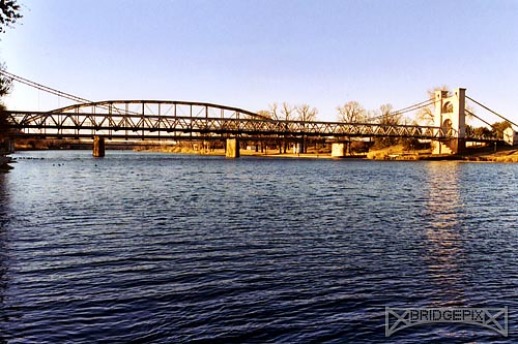the suspension bridge

The Waco Suspension Bridge crosses the Brazos River in Waco, Texas. It is a single-span suspension bridge with a main span of 475 feet (145 m). Opened in 1869, it contains nearly 3 million bricks. It is located north of Downtown Waco, connecting Indian Springs Park with M.L.K Jr. Park, which is north of the Brazos. Every year on Independence Day, the bridge serves as a place where thousands of locals crowd onto the bridge to party and watch fireworks. It is said that each year when all the people walk on the bridge, one can actually feel the bridge sway beneath your feet.[citation needed] Before 1869, crossing the Brazos River was a time-consuming and sometimes dangerous ordeal. The only way to cross the river was via ferry, and due to the location of Waco on the growing Chisholm Trail, local businessmen knew that a bridge was needed to support commerce. A charter was received from the state in 1866, with John A. Roebling and Son tapped to build. The construction was supervised by Thomas M. Griffith. Many feel that their experiences building the Waco Suspension Bridge helped them out when building the Brooklyn Bridge. Due to lack of machine shops in the Waco area, getting the materials to the building site was a journey in itself. The nearest railroad was 100 miles away, and the closest town with artisans with the skills needed was Galveston, over 212 miles (341 km) from the build site. Supplies were loaded onto a steamer in Galveston, and ferried to Bryan. From there, they were loaded onto wagons pulled by oxen. The pothole filled dirt road from Bryan to Waco was bad, even by 1800s Texas standards. The twin double-towers that anchored the span were considered to be a marvel of engineering at the time, containing nearly 3 million bricks, which, to the oxen’s rapture, were produced locally. The bridge collected its first toll on January 1st, 1870. While a plaque on the bridge claims the 475 foot span made it one of the longest single-span bridges in the world at the time, longer suspension bridges were already in use in the United States. The bridge was wide enough for stagecoaches to pass each other, or for cattle to cross one side of the bridge, and humans to cross the other side. Being the only bridge to cross the Brazos at the time, the cost of building the bridge, which was estimated to be $141,000 was quickly paid back. Tolls were 5 cents per head of cattle that crossed, along with a charge for pedestrian traffic. In 1889, the bridge was sold to McLennan County, which removed all tolls. In 1913-1914, major reconstruction occurred on the bridge, replacing the older steel with higher gauge, and trusses were added to accommodate the span to carry heavier weights. This doubled as a new pedestrian walkway. By 1971, the bridge had seen over 100 years of traffic. What started out as a Cattle Bridge had become a vehicular bridge, and the state historical committee decided that it was time to be retired, with larger and arguably safer bridges being built since the inception of the Waco Suspension Bridge. The bridge, by all accounts, helped to transform Waco from a small frontier town to a major commercial center.

